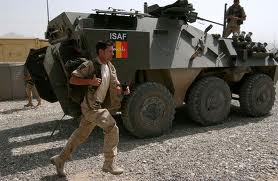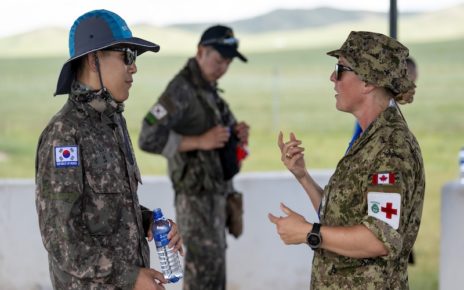British Prime Minister David Cameron was in Afghanistan on June 29, 2013, where he pledged to withdraw all British combat forces by the end of 2014. Visiting troops in Camp Bastion and Lashkar Gah, the Prime Minister sought to not only confirm the withdrawal date for British forces, but also discussed the nature of Britain’s commitment to Afghanistan beyond 2014. The end of combat operations in Afghanistan, for Britain and its allies, does not represent a full withdrawal of ISAF personnel. While contributing nations will continue to scale down their troop contributions this year, political and military leaders alike continue to debate the role of those who will remain.
[captionpix align=”right” theme=”elegant” width=”300″ imgsrc=”http://natoassociation.ca/wp-content/uploads/2013/07/afgh-1.jpg” captiontext=””]
In the case of Great Britain, Prime Minister Cameron confirmed on June 29 that the British will establish an officer-training academy in Afghanistan to assist in training Afghan security personnel in 2015. However, on the same day Cameron made this announcement, a Senior British Military official suggested that Afghan forces will require direct support from the UK for 3 to 5 years beyond this deadline. He argued that specific capacity-building efforts – regarding air support, casualty evacuation, and logistics in particular – will require more active support. The tension between war-weary constituents in Britain and the ongoing needs of the Afghan army is by no means unique to Great Britain. Though most NATO- and ISAF-contributing countries intend to withdraw by the end of next year, post-2014 plans remain obscure.
NATO’s most recent “concept of operations,” discussed in Brussels last month, describes a small training and advisory force to assist and support Afghan security personnel. It is still unknown how many troops will be deployed, given that the United States has not yet made a pledge of its own. However, in February 2012, US officials suggested a NATO force of approximately 8 000 to 12 000 personnel, as compared to the 100 000 service members that are in Afghanistan today. US Secretary of Defense Chuck Hagel has said that the United States will likely be the largest single contributor to post-2014 operations, and could commit anywhere from 3 000 to 9 000 troops. President Karzai announced last week that President Obama hoped to have a deal arranged by October 2013.
Alliance troops that remain in Afghanistan after 2014 will likely be assigned on a regional basis, as explained by NATO Secretary General Anders Fogh Rasmussen on June 5, 2013. He stressed that “the new mission will not be ISAF by another name. It will be different, and be significantly smaller. Its aim will be to train, advise, and assist the Afghan forces, not substitute for them.” At the time, he stated that ten Alliance partners have expressed their willingness to participate in a training capacity post-2014.
While withdrawal from combat operations in Afghanistan next year is undoubtedly significant after twelve years of war, rhetoric focusing on homecoming troops avoids a different, more uncomfortable reality: that this war isn’t over yet, and that there are several years left to serve. Most importantly, citizens in troop-contributing countries – now, and next year – cannot lose sight of the very real danger that troops of any capacity continue to face. The transition of NATO forces to a training and advisory role is unlikely to be recognized by insurgents who would do them harm. Recent ISAF casualties in Afghanistan – 13 last month and 63 this year – are a poignant reminder that boots on the ground are never far from danger. Troop withdrawals in the next year should not obscure or distract from the ongoing sacrifices of those who remain.
More substantive declarations of what the next step for international troops in Afghanistan will be remain elusive given the extent to which circumstances in Afghanistan may change in the next year. NATO transferred its leadership of security operations to Afghanistan’s armed forces only last month. Though they still conduct local security patrols and route clearances, NATO forces have deferred the initiative to Afghan security forces. The outcome of Afghanistan’s presidential election in April 2014 will be an important indicator for what major challenges will persist in the region. Local responses to these challenges will undoubtedly play a crucial role in determining what kind of support they will require from NATO in the future. For example, in addition to the British training academy, US Marine Corps General Joseph F. Dunford Jr. explained last month that the Afghan aviation program will demand US attention until at least 2017.
Approximately 950 Canadian Forces personnel have been involved in Afghanistan in a training and advisory capacity since July 2011, when their combat role in Afghanistan officially ended. At its peak, the Canadian war effort involved 2 950 Canadian soldiers and 120 civilian personnel. In June 2013, approximately 700 Canadian Forces personnel completed their training for what will be Canada’s final deployment. Their mission, as described by Colonel Lee Hamond, Deputy Commander of the Canadian Training Mission, is to further enable Afghan security forces so that they have the capacity to conduct future missions on their own.
However, Hammond acknowledges the risks that training and advisory missions entail. He explains, “[troops] are now traveling in smaller groups. The enemy is very difficult to see, so surprises happen and you may only be with a few other Canadian soldiers…Afghanistan’s come a long way, but there are still elements out there that would do us harm if they had the chance.” One Canadian solder has died since the Canadian Forces ended combat operations: Master Corporal Byron Greff was killed in October 2011, three months into Canada’s supervisory role.
Though Canadian Prime Minister Stephen Harper has confirmed a “firm and final end” to Canada’s military mission in Afghanistan by March 31, 2014, the Canadian government will continue to provide financial support to the Afghanistan National Security Forces (ANSF) until at least 2017. At NATO’s Chicago summit last year, Prime Minister Harper pledged CAD$110 million per year until then. However, as long as its allies have troops on the ground (in whatever capacity), the Canadian government will undoubtedly feel pressure to maintain financial contributions.
While training and advisory missions may indeed be significant after twelve years of active combat, this war is not over yet. So long as Canadian troops and their allies are in Afghanistan, they are at risk. Ending a war is no cleaner than starting one, and the risks of this transitional period should not go unacknowledged by the public at large.




